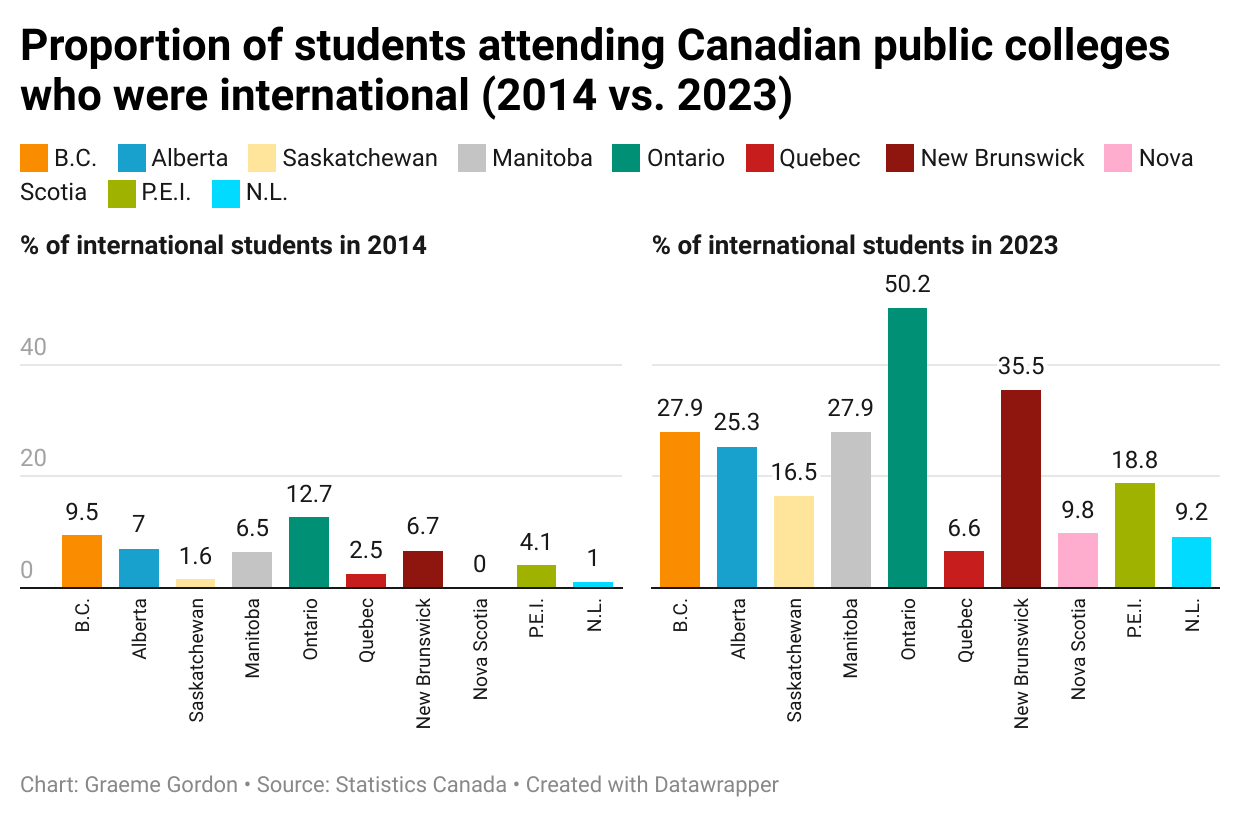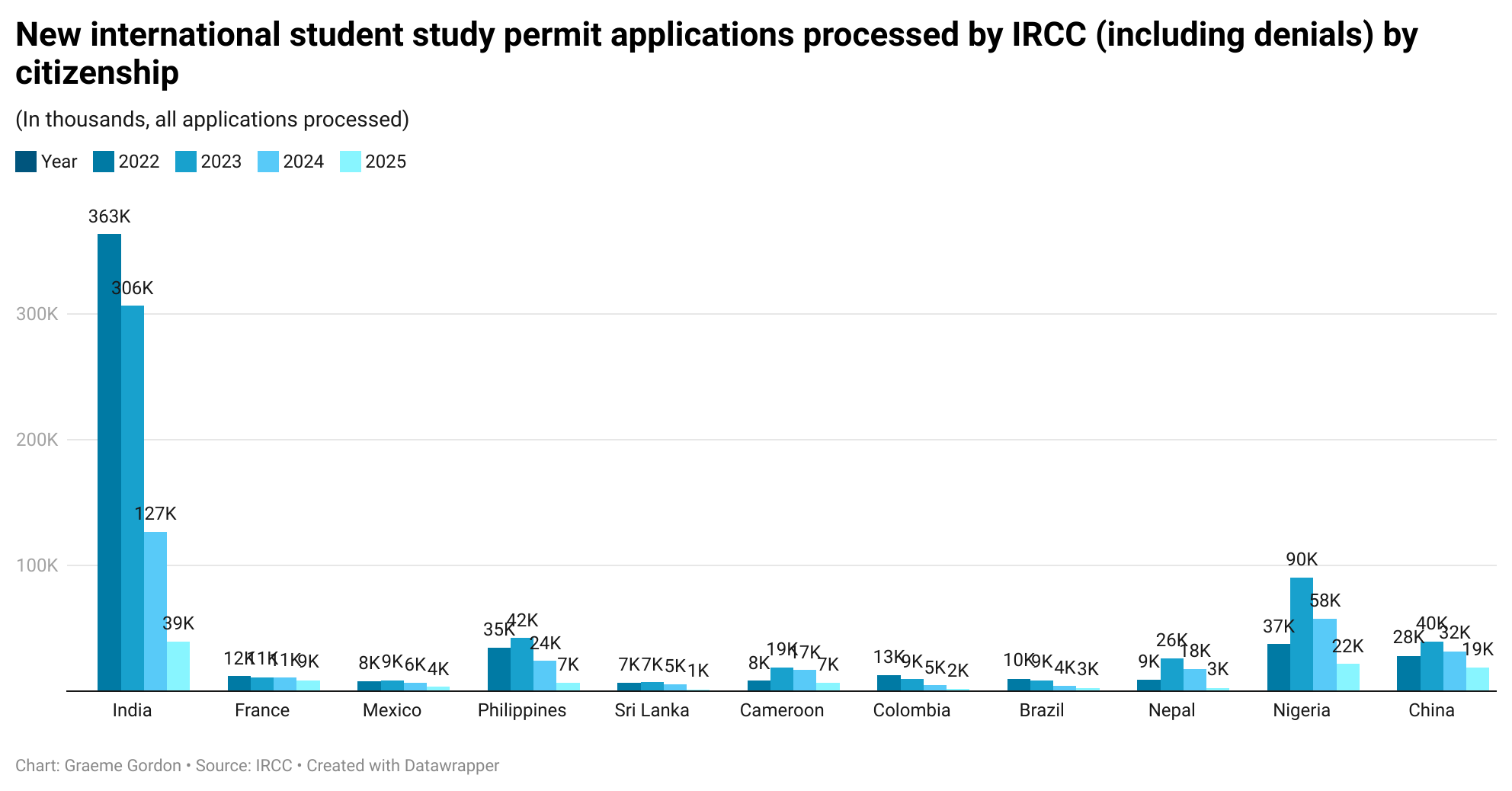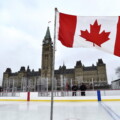The number of international students enrolled at Canadian public colleges skyrocketed 397 percent from 2014 to 2023, according to new data released by Statistics Canada.
Back in the 2014 school year, a total of 58,125 international students were enrolled in Canada’s public colleges. Nine years later, in 2023, international students attending public colleges jumped to 288,798.

A previous CBC investigation found that from 2021 to 2023, college enrollment (rather than universities) at 10 Ontario public colleges accounted for nearly 30 percent of all Canadian international student permits issued during the time period, with Conestoga College topping the list with 30,395 international student permits approved in 2023. The CBC found approved student permits to government-funded universities and colleges were vastly more than those for private colleges.
In 2014, Statistics Canada data on international college enrollment, minus undesignated students’ data, showed Chinese (26.6 percent of all students) was the top citizenship of those attending Canada’s public colleges, followed by Indian (26.1 percent), South Korean (5.5 percent ), French (four percent), and Saudi Arabian (2.4 percent).
Within nine years, the makeup of enrolled students attending Canadian public colleges changed dramatically, with international college students growing five times larger.
By the 2023 school year, India topped the list, with 58.8 percent of all international students hailing from that country. The other top four countries for international college students in descending order were the Philippines (6.5 percent), Nepal (3.9 percent), Nigeria (3.8 percent), and China (2.2 percent).
The number of Indian international students grew exponentially by 1,268 percent within the nine-year period, while the number of Chinese college students dropped by nearly 95.3 percent.
In 2023, overall international student enrollment in Canadian colleges hit a record 283,644, surpassing international student enrolled at Canadian universities (278,577) for the first time, according to Statistics Canada.
Federal government caps on international students curtail numbers
In 2023, in response to public outcry over the massive growth of international students and widespread student permit fraud, the Liberal federal government began to curtail new arrival numbers, including (for the first time) capping new university and college student permits to protect the “integrity of the international student system.”
For 2024, Immigration, Refugees and Citizenship Canada (IRCC) showed overall new student arrival permits (excluding asylum seekers and permit extensions) reached 293,160. Nine months into 2025, the federal government approved another 100,585 new international students, a 65.7 percent drop in new international students accepted at the same time last year.
This past August, 74 percent of Indian permit applications to study at Canadian post-secondary schools were rejected by the Government of Canada, according to Reuters.
The caps and more stringent process for application approvals have led to far fewer applications, especially from Indian students. In the first nine months of 2025, 39,250 Indians applied for new study permits at Canadian post-secondary institutions, way down from Indian application numbers from the previous three years: 363,315 (2022), 306,415 (2023), 126,870 (2024).

Ontario schools hit hardest
With the federal government cutting international study permits by another 10 percent this year, Ontario’s postsecondary institutions face the worst funding gap.
Previously, the schools had generated billions in revenue through premium tuition fees for foreign students, filling gaps created by frozen domestic tuition fees. Before the cap, the province’s colleges generated up to 30 percent of their revenue from international students.
“It’s a cash cow,” immigration lawyer Richard Kurland told the CBC. “Each student likely generates at least $20,000 for an educational institution, and we’re talking about thousands and thousands of students.”
As Ontario postsecondary institutions face immense financial strains from the dearth in revenues, the provincial minister of colleges, universities, research excellence and security, Nolan Quinn, is non-committal in extending the student tuition freeze past the 2026-27 school year.
Quinn also spoke with the 47 provincially-assisted Ontario colleges and universities to understand their financial pressures due to funding losses.
“It’s been over a decade since we’ve really looked at our funding formula review,” Quinn said. “And we’re looking at all aspects of it and understanding the costs have changed.”
What are the potential long-term economic consequences for Canadian colleges facing reduced international student enrollment?
How might the shift in international student demographics impact Canada's cultural landscape and educational institutions?
What are the primary reasons behind the federal government's decision to cap international student permits, and what are the immediate effects?










Comments (0)